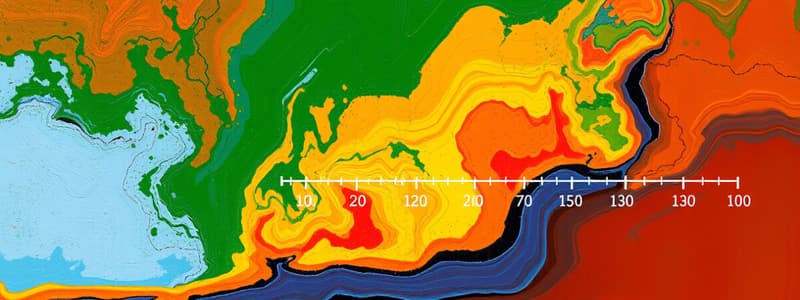Podcast
Questions and Answers
What are the three eons of the Precambrian period?
What are the three eons of the Precambrian period?
Proterozoic, Archean, Hadean
How old is the Earth approximately?
How old is the Earth approximately?
4.5 billion years
Which era is characterized by the presence of first reptiles?
Which era is characterized by the presence of first reptiles?
- Cenozoic Era
- Mesozoic Era
- Precambrian Eon
- Paleozoic Era (correct)
Gondwana started to break up during the Cretaceous period.
Gondwana started to break up during the Cretaceous period.
What significant event occurred during the Eocene epoch?
What significant event occurred during the Eocene epoch?
What was the land mass concentrated into during the Triassic period?
What was the land mass concentrated into during the Triassic period?
The first chordates appeared in the ______ period.
The first chordates appeared in the ______ period.
What is the time period of the Holocene epoch?
What is the time period of the Holocene epoch?
Flashcards are hidden until you start studying
Study Notes
Precambrian Eon
- Spans nearly 90% of Earth's history, divided into three eras: Hadean, Archean, and Proterozoic.
- Hadean (4,500 MYA): Formation of the Earth; a molten state with no solid crust.
- Archean (4,000 MYA): First stable continents formed; beginning of life with prokaryotic organisms.
- Proterozoic (2,500 MYA): Rise of multicellular organisms; oxygen levels increased due to photosynthetic bacteria.
Phanerozoic Eon
- Represents the current geological eon; characterized by the abundance of fossil records.
Paleozoic Era
- Cambrian (540 MYA): Emergence of hard-shelled organisms; first chordates and fishes.
- Ordovician (485 MYA): Major diversification event with an increase in marine life forms.
- Silurian (445 MYA): Evolution of vascular plants; colonization of land begins.
- Devonian (419 MYA): Known as the "Age of Fishes"; first amphibians appear.
- Carboniferous (359 MYA): Appearance of first reptiles and extensive forests of scale trees.
- Permian (299 MYA): Era marked by widespread deserts; significant geological changes as Pangaea forms.
Mesozoic Era
- Known as the age of dinosaurs; divided into three periods.
- Triassic (252 MYA): Concentrated land mass of Pangaea; increasing biodiversity.
- Jurassic (201 MYA): Pangaea begins to break apart; expanding dinosaur populations.
- Cretaceous (145 MYA): Continued breakup of Gondwana; significant mountain building activity.
Cenozoic Era
- Divided into three periods: Paleogene, Neogene, and Quaternary.
- Paleogene:
- Paleocene (66 MYA): Continued continental drift; India moves toward Asia.
- Eocene (56 MYA): Formation of the Himalayas; rise of the Alps in Europe.
- Oligocene (34 MYA): Antarctica becomes isolated; shifts in habitats.
- Neogene:
- Miocene (23 MYA): Emergence of the Andes mountain range; diversification of mammals.
- Pliocene (5 MYA): Initiation of the current ice age; Mediterranean Sea formation.
- Quaternary:
- Pleistocene (2.5 MYA): Multiple glacial cycles; major shifts in sea levels and continental positions.
- Holocene (11,700 YA): Period of human evolution; significant global climatic changes.
Key Facts
- Earth is around 4.5 billion years old, with two main eons: Precambrian and Phanerozoic, the latter containing significant biological and geological developments.
Studying That Suits You
Use AI to generate personalized quizzes and flashcards to suit your learning preferences.



